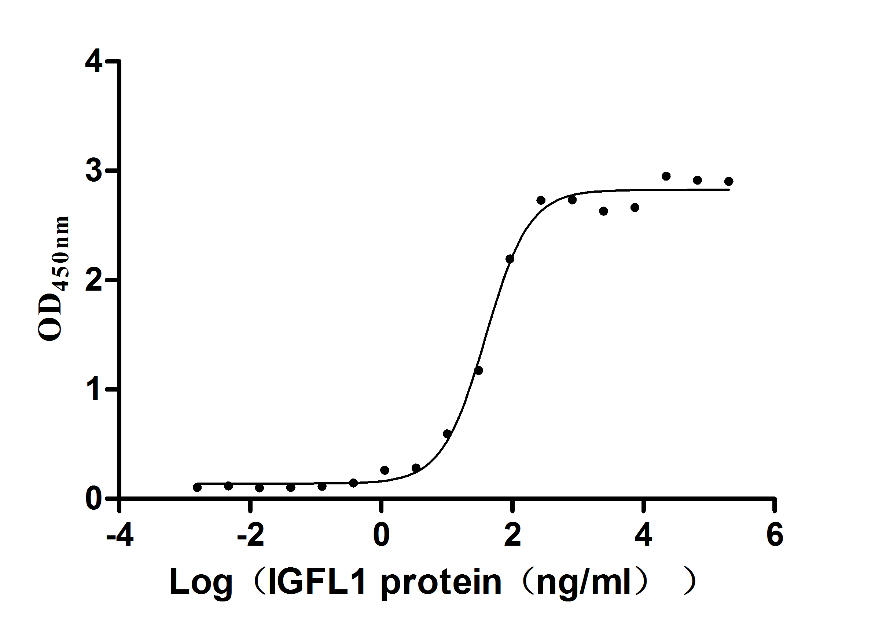Recombinant Human Potassium channel subfamily T member 2 (KCNT2), partial
-
中文名稱:人KCNT2重組蛋白
-
貨號:CSB-YP747624HU
-
規(guī)格:
-
來源:Yeast
-
其他:
-
中文名稱:人KCNT2重組蛋白
-
貨號:CSB-EP747624HU
-
規(guī)格:
-
來源:E.coli
-
其他:
-
中文名稱:人KCNT2重組蛋白
-
貨號:CSB-EP747624HU-B
-
規(guī)格:
-
來源:E.coli
-
共軛:Avi-tag Biotinylated
E. coli biotin ligase (BirA) is highly specific in covalently attaching biotin to the 15 amino acid AviTag peptide. This recombinant protein was biotinylated in vivo by AviTag-BirA technology, which method is BriA catalyzes amide linkage between the biotin and the specific lysine of the AviTag.
-
其他:
-
中文名稱:人KCNT2重組蛋白
-
貨號:CSB-BP747624HU
-
規(guī)格:
-
來源:Baculovirus
-
其他:
-
中文名稱:人KCNT2重組蛋白
-
貨號:CSB-MP747624HU
-
規(guī)格:
-
來源:Mammalian cell
-
其他:
產(chǎn)品詳情
-
純度:>85% (SDS-PAGE)
-
基因名:KCNT2
-
Uniprot No.:
-
別名:KCNT2; SLICKPotassium channel subfamily T member 2; Sequence like an intermediate conductance potassium channel subunit; Sodium and chloride-activated ATP-sensitive potassium channel Slo2.1
-
種屬:Homo sapiens (Human)
-
蛋白長度:Partial
-
蛋白標簽:Tag?type?will?be?determined?during?the?manufacturing?process.
The tag type will be determined during production process. If you have specified tag type, please tell us and we will develop the specified tag preferentially. -
產(chǎn)品提供形式:Lyophilized powder
Note: We will preferentially ship the format that we have in stock, however, if you have any special requirement for the format, please remark your requirement when placing the order, we will prepare according to your demand. -
復(fù)溶:We recommend that this vial be briefly centrifuged prior to opening to bring the contents to the bottom. Please reconstitute protein in deionized sterile water to a concentration of 0.1-1.0 mg/mL.We recommend to add 5-50% of glycerol (final concentration) and aliquot for long-term storage at -20℃/-80℃. Our default final concentration of glycerol is 50%. Customers could use it as reference.
-
儲存條件:Store at -20°C/-80°C upon receipt, aliquoting is necessary for mutiple use. Avoid repeated freeze-thaw cycles.
-
保質(zhì)期:The shelf life is related to many factors, storage state, buffer ingredients, storage temperature and the stability of the protein itself.
Generally, the shelf life of liquid form is 6 months at -20°C/-80°C. The shelf life of lyophilized form is 12 months at -20°C/-80°C. -
貨期:Delivery time may differ from different purchasing way or location, please kindly consult your local distributors for specific delivery time.Note: All of our proteins are default shipped with normal blue ice packs, if you request to ship with dry ice, please communicate with us in advance and extra fees will be charged.
-
注意事項:Repeated freezing and thawing is not recommended. Store working aliquots at 4°C for up to one week.
-
Datasheet :Please contact us to get it.
靶點詳情
-
功能:Outward rectifying potassium channel. Produces rapidly activating outward rectifier K(+) currents. Activated by high intracellular sodium and chloride levels. Channel activity is inhibited by ATP and by inhalation anesthetics, such as isoflurane. Inhibited upon stimulation of G-protein coupled receptors, such as CHRM1 and GRM1.
-
基因功能參考文獻:
- Pathogenic Phe240Leu mutation in KCNT2 channel changes ion selectivity. PMID: 29069600
- In the present study, we evaluated two other potential mechanisms for stabilization of Slo2 channels in a closed state: (1) dewetting and collapse of the inner pore (hydrophobic gating) and (2) constriction of the inner pore by tight criss-crossing of the cytoplasmic ends of the S6 alpha-helical segments. PMID: 27682982
- mRNA of aquaporin 1 was co-expressed in Xenopus oocytes with homomeric or heteromeric Slick and Slack alpha-subunits. Hypotonic or hypertonic buffers caused changes in current. The heteromeric channel had a characteristic graded sensitivity to small and fast changes in cell volume. This the cell volume sensitivity is dependent on the number of volume sensitive Slick alpha-subunits in the tetrameric channels. PMID: 28222129
- KCNT2 SNPs were associated with lifetime cannabis use, but the association did not reach genome-wide significance. [Meta-Analysis] PMID: 27023175
- Together these results suggest that hydrophobic interactions between residues in S5 and the C-terminal end of the pore helix stabilize Slo2.1 channels in a closed state. PMID: 26724206
- Charge reversal of Asp757 of Slo2.1 prevented activation of channels by intracellular Na+, whereas activation by niflumic acid was unaffected. PMID: 25903137
- Slick channels, in contrast to the similar Slack channels, are the only high-conductance K+ channels strongly sensitive to small changes in cell volume. PMID: 25347289
- Together these findings suggest that (1) the selectivity filter and not the bundle crossing gates ion permeation and (2) dynamic coupling between the pore helix and the S5 and S6 segments mediates Slo2.1 channel activation. PMID: 24166878
- Cloning and regulation of slick channel activity. PMID: 14684870
顯示更多
收起更多
-
亞細胞定位:Cell membrane; Multi-pass membrane protein.
-
蛋白家族:Potassium channel family, Calcium-activated (TC 1.A.1.3) subfamily, KCa4.2/KCNT2 sub-subfamily
-
數(shù)據(jù)庫鏈接:
Most popular with customers
-
Recombinant Mouse Desmoglein-3 (Dsg3), partial (Active)
Express system: Mammalian cell
Species: Mus musculus (Mouse)
-
Recombinant Human HLA class II histocompatibility antigen gamma chain (CD74), partial (Active)
Express system: Mammalian cell
Species: Homo sapiens (Human)
-
Recombinant Human IGF-like family receptor 1 (IGFLR1), partial (Active)
Express system: Mammalian cell
Species: Homo sapiens (Human)
-
Recombinant Mouse Transthyretin (Ttr) (Active)
Express system: Mammalian cell
Species: Mus musculus (Mouse)
-
Recombinant Human Claudin-9 (CLDN9)-VLPs (Active)
Express system: Mammalian cell
Species: Homo sapiens (Human)
-
Recombinant Human Claudin-3 (CLDN3)-VLPs (Active)
Express system: Mammalian cell
Species: Homo sapiens (Human)
-
Recombinant Macaca fascicularis lymphocyte antigen 6 family member G6D (LY6G6D) (Active)
Express system: Yeast
Species: Macaca fascicularis (Crab-eating macaque) (Cynomolgus monkey)
-
Recombinant Human Cell adhesion molecule 1 (CADM1), partial (Active)
Express system: Mammalian cell
Species: Homo sapiens (Human)



-AC1.jpg)














